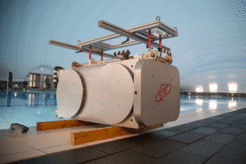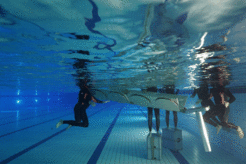Icarus antenna passes float test
Antenna model of the observation system is ready for underwater training of cosmonauts
The countdown is on: In the summer of 2017, a Soyuz rocket will transport the antenna of the Icarus animal observation system to the International Space Station (ISS). This is the long anticipated starting signal for a unique project by scientists at the Max Planck Institute for Ornithology in Radolfzell, who plan to investigate the behaviour of animals worldwide. First, however, the system components must undergo rigorous testing. A model of the Icarus antenna has now been shown to float perfectly in an underwater test. This is a prerequisite for the crew of the ISS to be able to practice assembling the antenna in a pool.

Although the site of the float test was on Earth, the ambience seemed rather “extraterrestrial”. Scientists and engineers tested a model of the antenna in the air dome of the spa in Constance. Cosmonauts will use the model to practise assembling the real antenna on the ISS. The model has proved to have the exact characteristics required for cosmonaut training. “We’re all delighted with the result. The antenna model floats perfectly in water in all positions,” says Wolfgang Pitz, Managing Director of the SpaceTech company in Immenstaad that developed the antenna.
The cosmonauts will practice assembling the antenna with the model in order not place undue stress on the real Icarus antenna. The antenna is made of metal and is indistinguishable from the original in appearance. However, instead of electronic components, the model is filled with polystyrene foam. The floating characteristics of the model can be modulated by varying the quantity and distribution of the foam. For the cosmonauts to be able to practice assembling the antenna under water, the model must be neither too light nor too heavy. Provided that the model floats under water in all positions, it is possible to simulate low-orbit working conditions in a pool.
Developing the antenna model was therefore a daunting challenge. “We calculated the design of the model precisely beforehand so that it doesn’t rise to the surface, turn or sink to the bottom of the pool – either in the folded or the deployed state. The test results have confirmed that our calculations were exactly right,” says Pitz.

The cosmonauts can now begin their training on the antenna model at the test grounds in Moscow. The Icarus antenna itself is currently being coated with protective paint before the electronics are installed, which will send and receive signals to and from transmitters. The SpaceTech engineers will then subject the antenna to a vibration test to make sure it is able to withstand the extreme vibrations it will have to endure during launch. It also has to be shown that the model will function flawlessly under the temperature and pressure conditions of space, and that it is compatible with the other electronic equipment on the ISS.
If all these tests are as successful as the float test in Constance, the antenna will be handed over to the Russian Space Agency Roscosmos at the end of March 2017.

